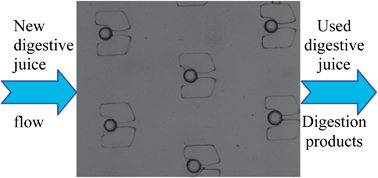A microfluidic device to study the digestion of trapped lipid droplets
Abstract
At the junction of chemistry, physics and biology, digestion involves many processes. Studying the mechanisms in such a complex system is challenging because numerous interactions coexist. Even in an apparently simple system such as an emulsion, many physicochemical characteristics affect lipid digestion. Moreover, these characteristics are difficult to control using conventional in vitro techniques. The goal of this work was to design a microfluidic device allowing the study of well-controlled individual oil droplets under gastrointestinal digestion conditions. Different parameters were investigated in order to validate the relevance of this device compared to conventional in vitro techniques using emulsions. Various triglycerides and digestion conditions were tested with droplets of the same initial diameter generated by a flow focusing device, then placed in individual traps of a microfluidic chamber for digestion with continuous digestive juice renewal. The results are in good agreement with those obtained with conventional in vitro techniques and open the way to screening of lipid digestion, in particular, bioaccessibility of lipophilic molecules, a prerequisite for bioavailability studied in nutrition, pharmacology, and toxicology.


 Please wait while we load your content...
Please wait while we load your content...